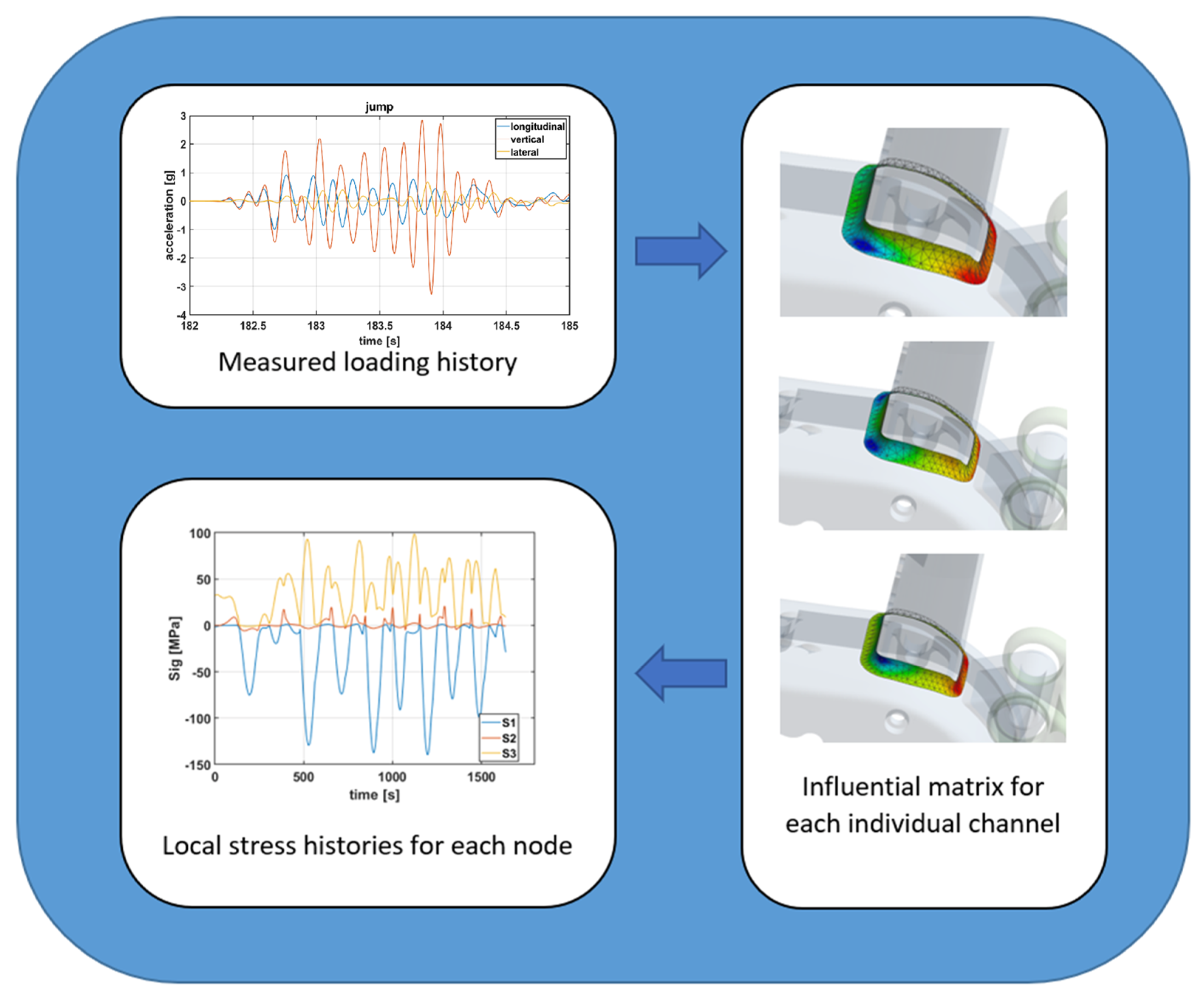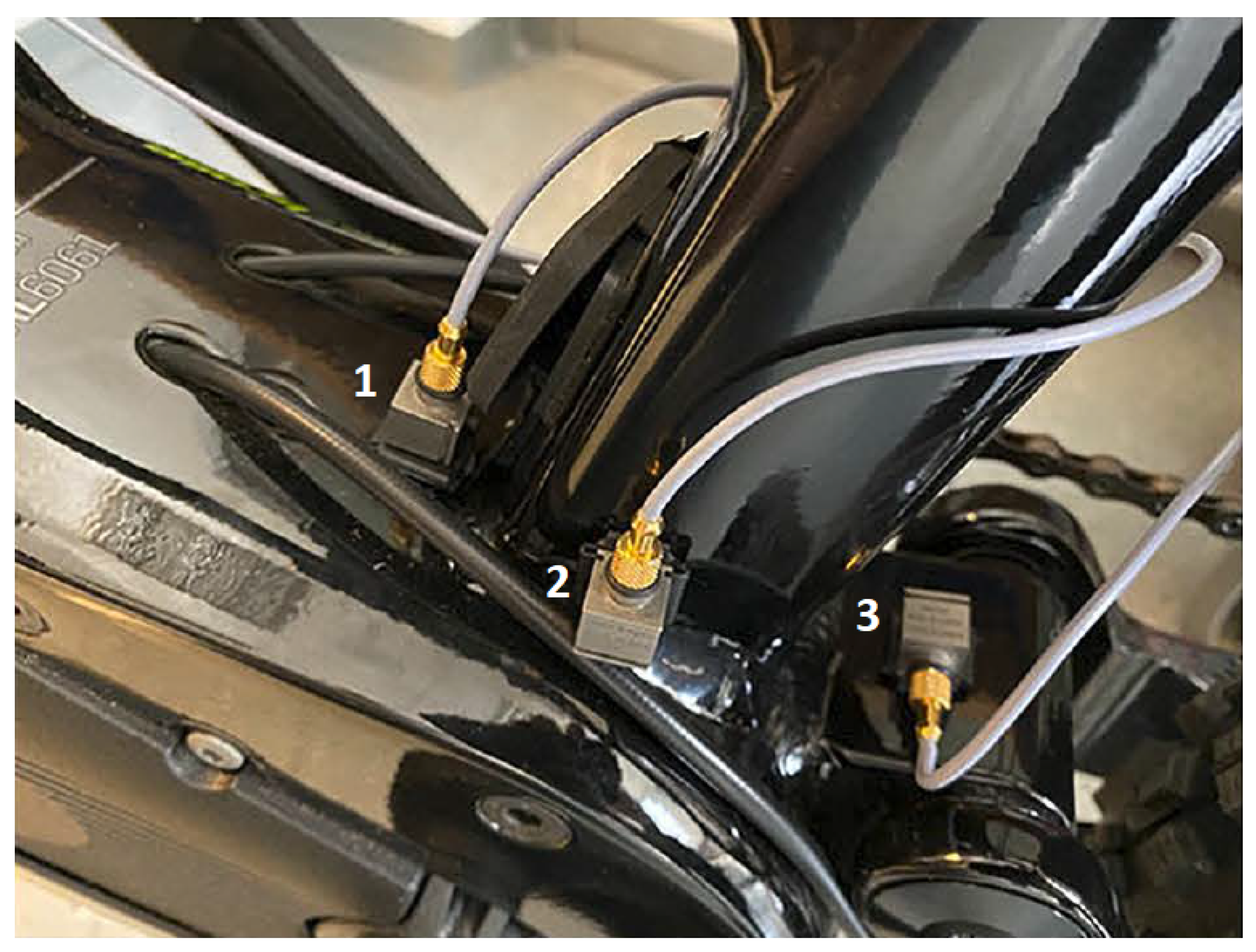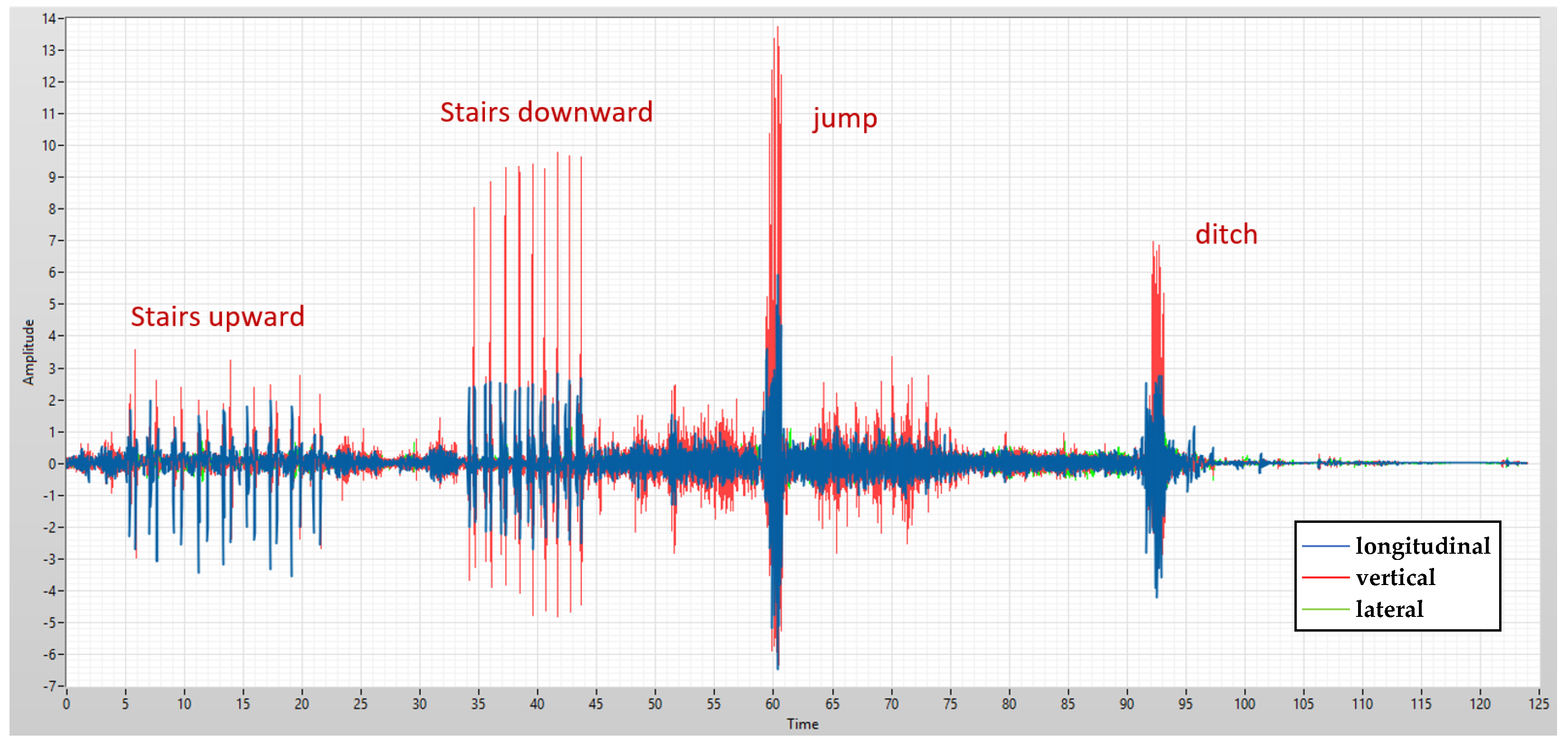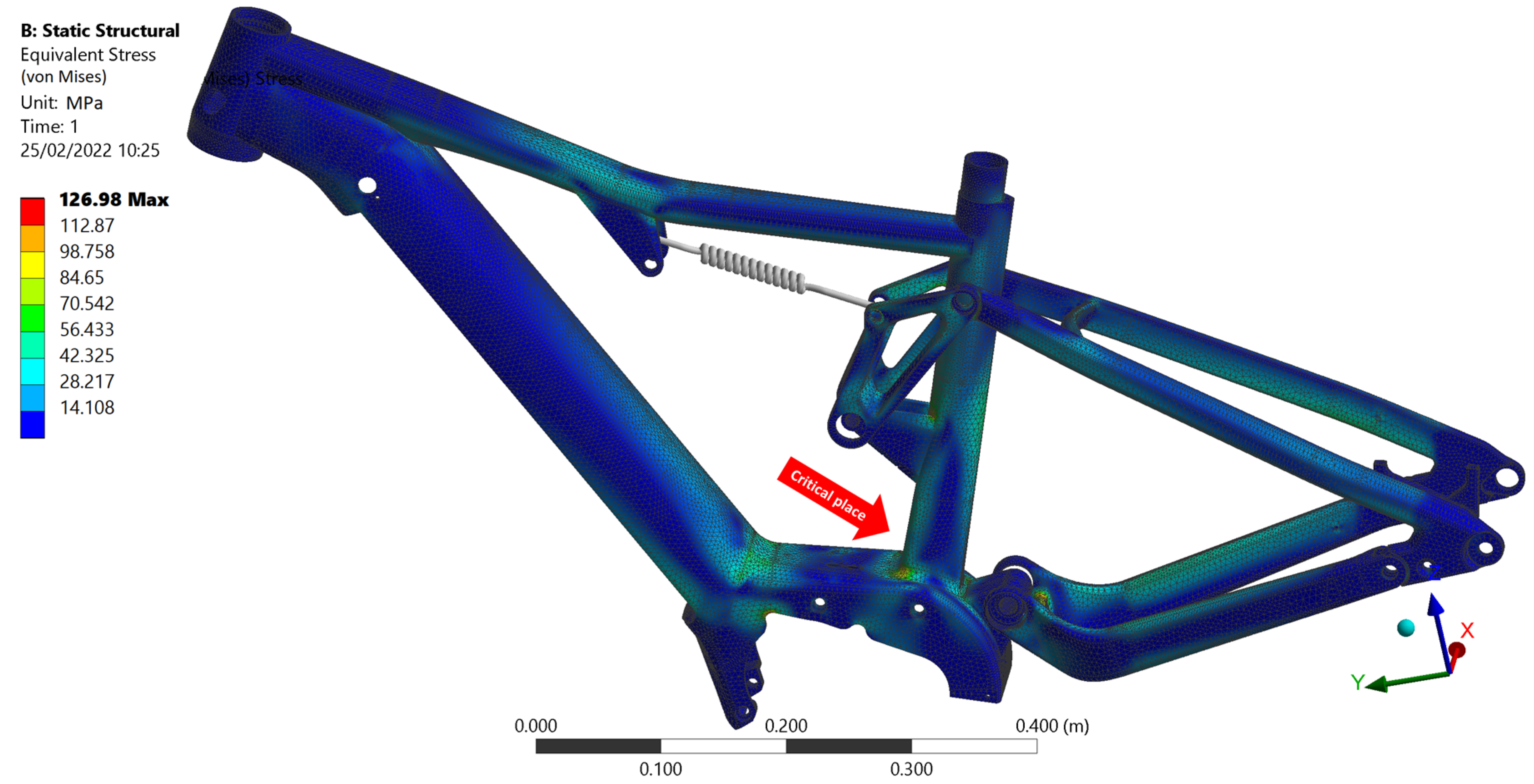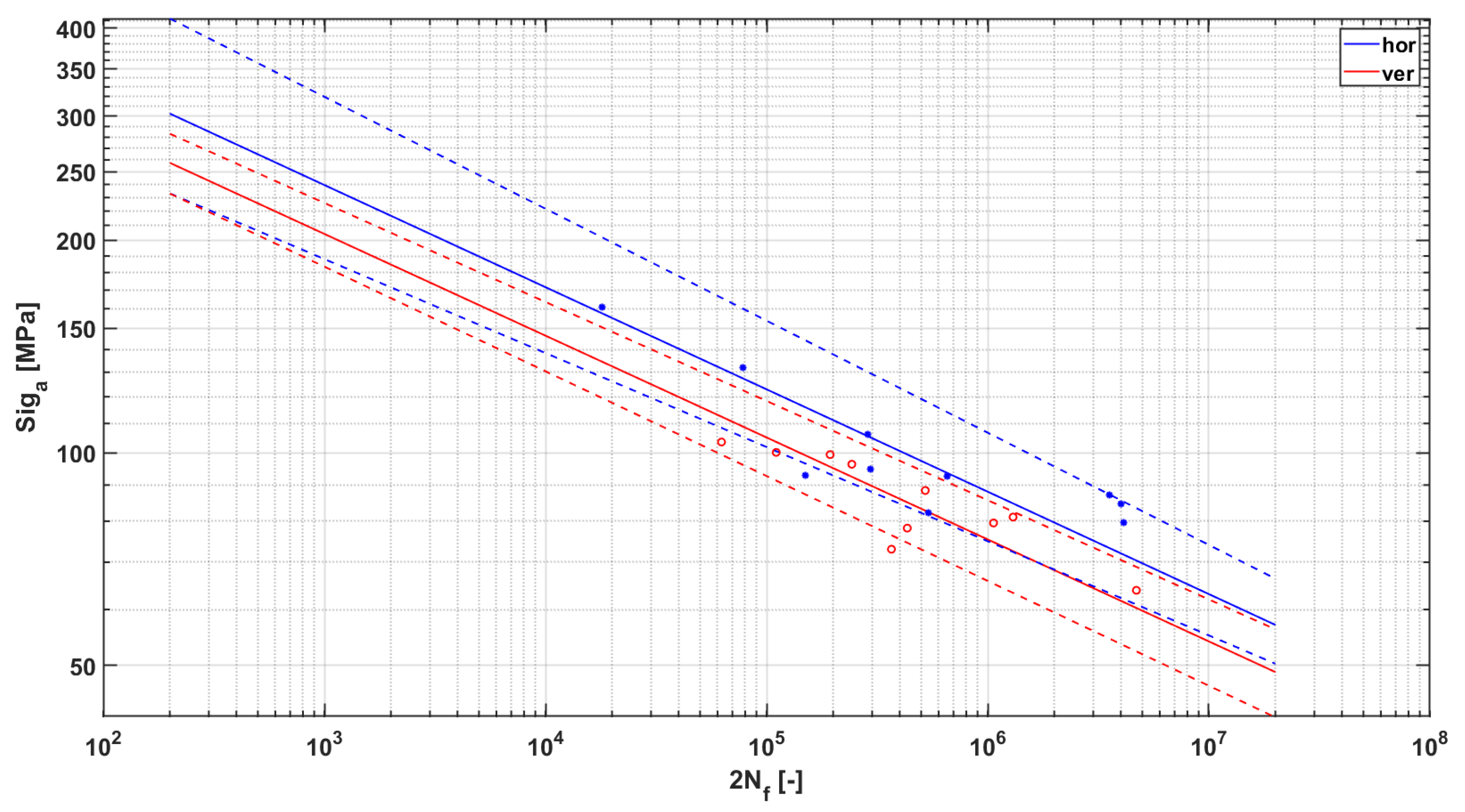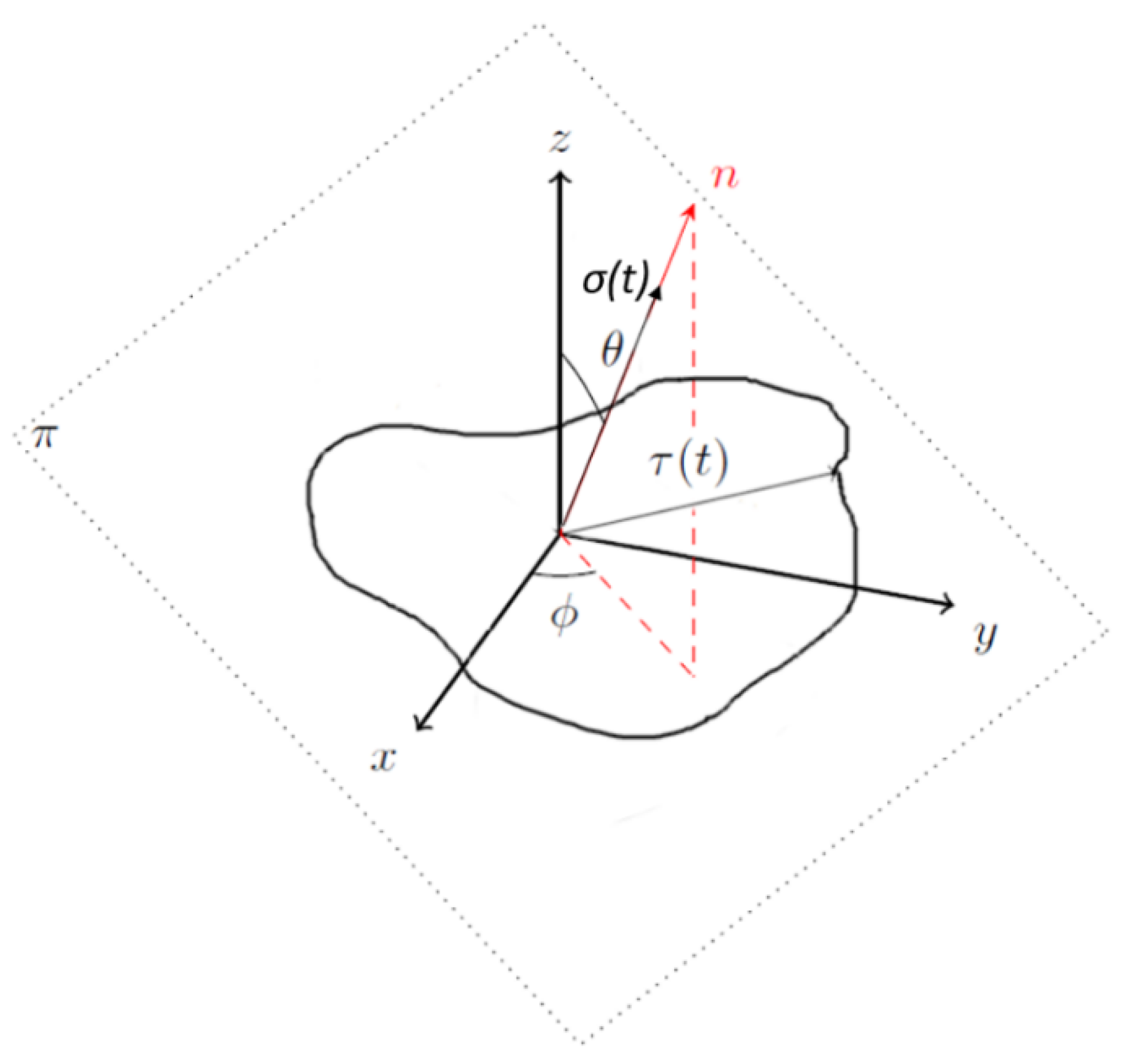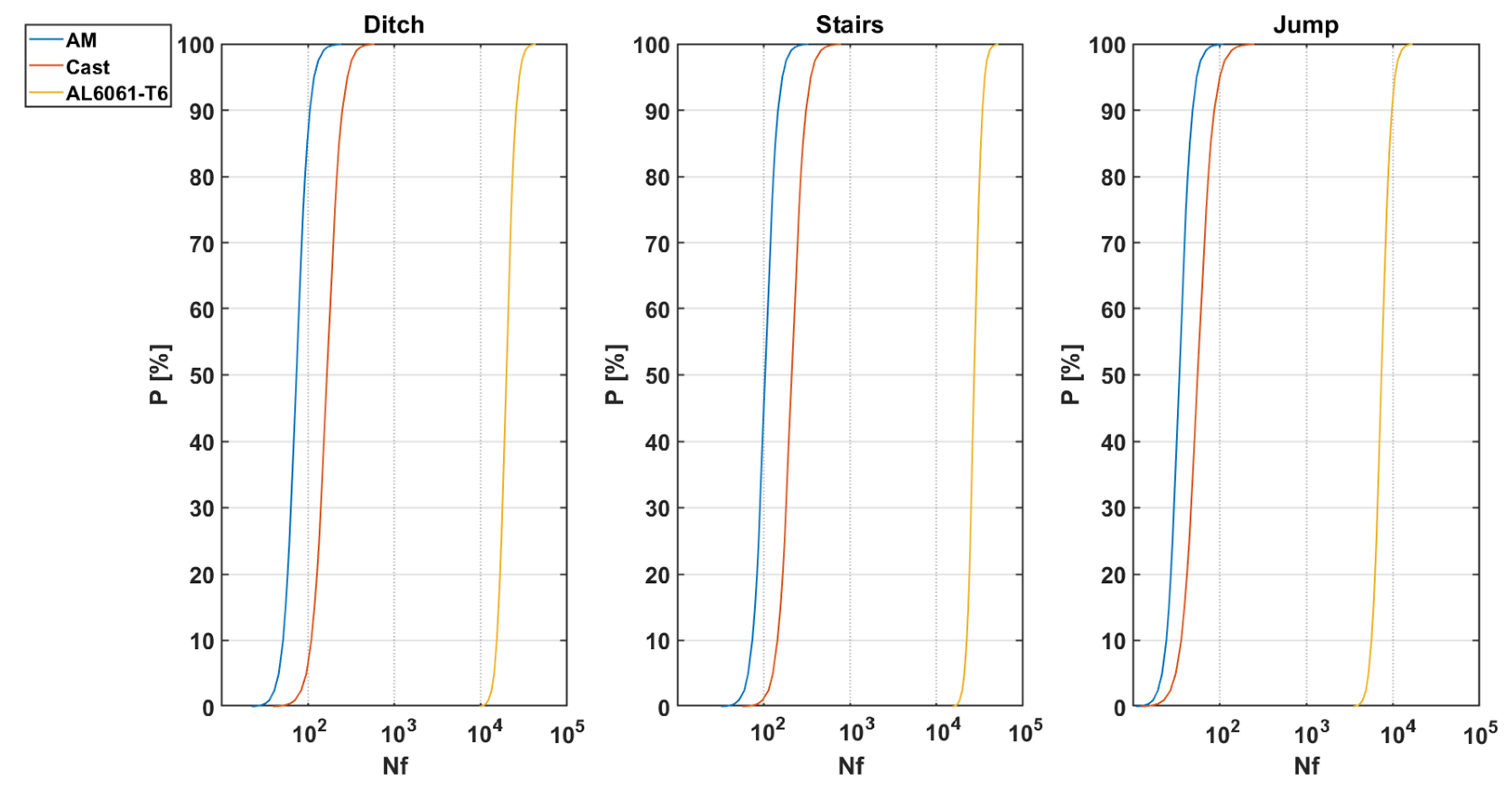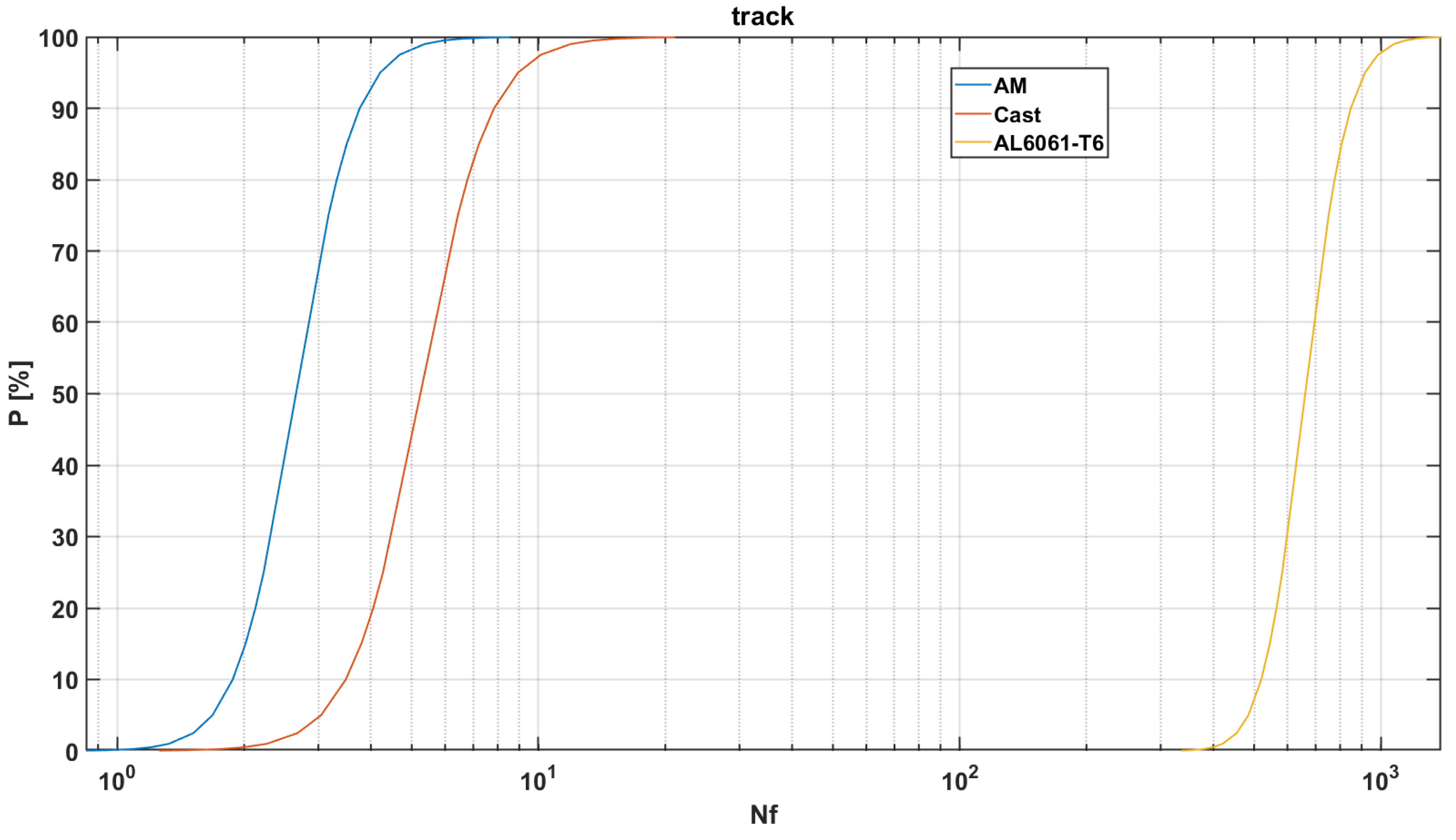Author Contributions
Computing, M.M. and R.Ď.; conceptualization and methodology, V.C.; computing simulations, M.S. and T.K.; experiments, M.S., M.M. and V.C. All authors have read and agreed to the published version of the manuscript.
Funding
This research was funded by the Slovak Research and Development Agency under the contract No. APVV-17-0666 and Slovak Educational Grant Agency under the contract No. KEGA 041STU4/2020 and Czech Technological Agency under the contract No. TREND FW01010462.
Institutional Review Board Statement
Not applicable.
Informed Consent Statement
Not applicable.
Data Availability Statement
Not applicable.
Conflicts of Interest
The authors declare no conflict of interest.
Nomenclature
| kfin | coefficient weighting the normal stress by Findley criterion |
| σn,max | maximal normal stress acting on plane during cycle |
| τa,cr | shear stress amplitude acting on critical plane |
| Nf | number of cycles to failure |
| τ*f | Findley’s fatigue strength coefficient |
| b | fatigue strength exponent for tension/compression loading |
| σ′f | fatigue strength coefficient for tension/compression loading |
| σc,R = −1 | fatigue limit (Nf = 2e6) for tension/compression fully reversed loading |
| σc,R = 0 | fatigue limit (Nf = 2e6) for tension/compression pulsating loading |
| PI | prediction interval |
References
- Lewandowski, J.J.; Seifi, M.; Clarke, D.R. Metal Additive Manufacturing: A Review of Mechanical Properties. Annu. Rev. Mater. Res. 2016, 46, 151–186. [Google Scholar] [CrossRef]
- Aboulkhair, N.T.; Simonelli, M.; Parry, L.; Ashcroft, I.; Tuck, C.; Hague, R. 3D printing of Aluminium alloys, Additive Manufacturing of Aluminium alloys using selective laser melting. Prog. Mater. Sci. 2019, 106, 100578. [Google Scholar] [CrossRef]
- Molaei, R.; Fatemi, A. Fatigue Design with Additive Manufactured Metals. Procedia Eng. 2018, 213, 5–16. [Google Scholar] [CrossRef]
- Yadollahi, A.; Mahmoudi, M.; Elwany, A.; Doude, H.; Bian, L.K.; Newman, J.C. Fatigue-life prediction of additively manufactured material: Effects of heat treatment and build orientation. Fatigue Fract. Eng. Mater. Struct. 2020, 43, 831–844. [Google Scholar] [CrossRef]
- Enrique, P.D.; Keshavarzkermani, A.; Esmaeilizadeh, R.; Peterkin, S.; Jahed, H.; Toyserkani, E.; Zhou, N.Y. Enhancing fatigue life of additive manufactured parts with electrospark deposition post-processing. Addit. Manuf. 2020, 36, 101526. [Google Scholar] [CrossRef]
- Uzan, N.E.; Shneck, R.; Yeheskel, O.; Frage, N. Fatigue of AlSi10Mg specimens fabricated by additive manufacturing selective laser melting (AM-SLM). Mater. Sci. Eng. 2017, 704, 229–237. [Google Scholar] [CrossRef]
- Leon, A.; Shirizly, A.; Aghion, E. Corrosion Behavior of AlSi10Mg Alloy Produced by Additive Manufacturing (AM) vs. Its Counterpart Gravity Cast Alloy. Metals 2016, 6, 148. [Google Scholar] [CrossRef]
- Zhuo, L.; Wang, Z.; Zhang, H.; Yin, E.; Wang, Y.; Xu, T.; Li, C. Effect of post-process heat treatment on microstructure and properties of selective laser melted AlSi10Mg alloy. Mater. Lett. 2019, 234, 196–200. [Google Scholar] [CrossRef]
- Fousová, M.; Dvorský, D.; Michalcová, A.; Vojtěch, D. Changes in the microstructure and mechanical properties of additively manufactured AlSi10Mg alloy after exposure to elevated temperatures. Mater. Charact. 2018, 137, 119–126. [Google Scholar] [CrossRef]
- Tůma, J. Vehicle Gearbox Noise and Vibration: Measurement, Signal Analysis, Signal Processing and Noise Reduction Measures; Wiley: Hoboken, NJ, USA, 2014. [Google Scholar] [CrossRef]
- Chmelko, V. Cyclic anelasticity of metals. Cyclic anelasticity of metals. Metl. Mater. 2014, 52, 353–359. [Google Scholar] [CrossRef][Green Version]
- Chmelko, V.; Harakaľ, M.; Žlábek, P.; Margetin, M.; Ďurka, R. Simulation of Stress Concentrations in Notches. Metals 2022, 12, 43. [Google Scholar] [CrossRef]
- Tipton, S.M. Multiaxial plasticity and fatigue life prediction in coiled tubing. In Advances in Fatigue Lifetime Predictive Techniques: 3rd Volume; Mitchell, M.R., Landgraf, R.W., Eds.; ASTM International: Montgomery County, MD, USA, 1996; pp. 283–304. [Google Scholar] [CrossRef]
- Kliman, V. Probabilistic approach to operational fatigue-life evaluation. Part II. Calculation of fatigue-life distribution function with respect to inhomogeneity of material properties and random loading. Kov. Mater. Met. Mater. 1999, 37, 18–33. [Google Scholar]
- Kliman, V.; Kepka, M.; Václavík, J. Influence of scatter of cyclic properties of material on operational endurance of construction. Kov. Mater. Met. Mater. 2010, 48, 367–378. [Google Scholar] [CrossRef]
- Bannantine, A.J.; Socie, D.F. A variable amplitude multiaxial fatigue life prediction method. In Fatigue Under Biaxial and Multiaxial Loading, European Structural Integrity Society ESIS Publication 10; Mechanical Engineering Publications: London, UK, 1991; pp. 367–370. [Google Scholar]
- Wang, C.H.; Brown, M.W. Life prediction techniques for variable amplitude multiaxial fatigue—Part 1: Theories. J. Eng. Mater. Technol. 1996, 14, 367–370. [Google Scholar] [CrossRef]
- Wang, C.H.; Brown, M.W. Life prediction techniques for variable amplitude multiaxial fatigue—Part 2: Comparison with experimental results. J. Eng. Mater. Technol. 1996, 118, 371–374. [Google Scholar] [CrossRef]
- Anes, V.; Reis, L.; Li, B.; de Freitas, M. New cycle counting method for multiaxial fatigue. Int. J. Fatigue 2014, 67, 78–94. [Google Scholar] [CrossRef]
- Wang, X.-W.; Shang, D.-G.; Sun, Y.-J.; Liu, X.-D. Algorithms for multiaxial cycle counting method and fatigue life prediction based on the weight function critical plane under random loading. Int. J. Damage Mech. 2019, 28, 1367–1392. [Google Scholar] [CrossRef]
- Meggiolaro, M.A.; de Castro, J.T.P. An improved multiaxial rainflow algorithm for non-proportional stress or strain histories—Part I: Enclosing surface methods. Int. J. Fatigue 2012, 42, 217–226. [Google Scholar] [CrossRef]
- Meggiolaro, M.A.; de Castro, J.T.P. An improved multiaxial rainflow algorithm for non-proportional stress or strain histories—Part II: The Modified Wang-Brown method. Int. J. Fatigue 2012, 42, 194–206. [Google Scholar] [CrossRef]
- Margetin, M.; Biro, D. Multiaxial cycle counting method for non-proportional multiaxial variable loading signals based on modified maximal shear stress. MATEC Web Conf. 2019, 300, 17003. [Google Scholar] [CrossRef]
- Findley, W.N. Fatigue of metals under combinations of stresses. Trans. ASME 1957, 79, 1337–1347. [Google Scholar] [CrossRef]
- Findley, W.N. A theory for the effect of mean stress on fatigue of metals under combined torsion and axial load or bending. Trans. ASME 1959, 81, 301–305. [Google Scholar] [CrossRef]
- McDiarmid, D.L. A general criterion for high cycle multiaxial fatigue failure. Fatigue Fract. Eng. Mater. Struct. 1991, 14, 429–453. [Google Scholar] [CrossRef]
- McDiarmid, D.L. A shear stress based critical plane criterion of multiaxial fatigue failure for design and life prediction. Fatigue Fract. Engng. Mater. Struct. 1994, 17, 1475–1484. [Google Scholar] [CrossRef]
- Dang Van, K.; Griveau, B.; Message, O. On a New Multiaxial Fatigue Limit Criterion: Theory and Application. Biaxial and Multiaxial Fatigue, EGF 3; Mechanical Engineering Publications: London, UK, 1989; pp. 479–496. [Google Scholar]
- Dang-Van, K. Macro-micro approach in high-cycle multiaxial fatigue. In Advances in Multiaxial Fatigue; ASTM STP 1191; McDowell, D.L., Ellis, R., Eds.; American Society for Testing and Materials: Philadelphia, PA, USA, 1993; pp. 120–130. [Google Scholar]
- Carpinteri, A.; Spagnoli, A. Multiaxial high-cycle fatigue criterion for hard metals. Int. J. Fatigue 2001, 23, 135–145, ISSN 0142-1123. [Google Scholar] [CrossRef]
- Fatemi, A.; Socie, D.F. A critical plane approach to multiaxial fatigue damage including out-of-phase loading. Fatigue Fract. Eng. Mater. Struct. 1988, 11, 149–165. [Google Scholar] [CrossRef]
- Brown, M.W.; Miller, K.J. A Theory for Fatigue Failure under Multiaxial Stress-Strain Conditions. Proc. Inst. Mech. Eng. 1973, 187, 745–755. [Google Scholar] [CrossRef]
- Smith, R.N.; Watson, P.; Topper, T.H. A stress-strain parameter for the fatigue of metals. J. Mater. 1970, 5, 767–778. [Google Scholar]
- Margetin, M.; Ďurka, R.; Chmelko, V. Multiaxial fatigue criterion based on parameters from torsion and axial S-N curve. Frat. Ed Integrita Strutt. 2016, 10, 146–152. [Google Scholar] [CrossRef]
- Morrow, J. Fatigue Properties of Metals. In Fatigue Design Handbook; Section 3.2, Pub. No. AE-4; Society of Automotive Engineers: Warrendale, PA, USA, 1968. [Google Scholar]
- Palmgren, A.G. Die Lebensdauer von Kugellagern (Life Length of Roller Bearings or Durability of Ball Bearings). Zeitschrift des Vereines Deutscher Ingenieure (ZVDI), 14, 339-341.Miner, M.A. (1945) Cumulative Damage in Fatigue. J. Appl. Mech. 1924, 3, 159–164. [Google Scholar]
- Darrell, S.; Marquis, G.B. Multiaxial Fatigue; Society of Automotive Engineers: Warrendale, PA, USA, 2000. [Google Scholar]
- Araújo, J.A.; Dantas, A.P.; Castro, F.C.; Mamiya, E.N.; Ferreira, J.L.A. On the characterization of the critical plane with a simple and fast alternative measure of the shear stress amplitude in multiaxial fatigue. Int. J. Fatigue 2011, 33, 1092–1100. [Google Scholar] [CrossRef]
- Van Dang, K.; Le Douaron, A.; Lieurade, H.P. Multiaxial Fatigue Limit: A New Approach. Fracture 84; Elsevier: Amsterdam, The Netherlands, 1984; pp. 1879–1885. [Google Scholar] [CrossRef]
- Graham, R.L. An efficient algorith for determining the convex hull of a finite planar set. Informat. Process. Lett. 1972, 1, 132–133. [Google Scholar] [CrossRef]
- Anes, V.; Reis, L.; Freitas, M. Effect of Shear/Axial Stress Ratio on Multiaxial Non-Proportional Loading Fatigue Damage on AISI 303 Steel. Metals 2022, 12, 89. [Google Scholar] [CrossRef]
Figure 1.
Estimating loading histories in the critical place.
Figure 2.
Accelerometer positions on bicycle frame: 1—longitudinal direction (x); 2—lateral direction (y); 3—vertical direction (z).
Figure 3.
Measured signal before filtering.
Figure 4.
Filtered signals for each obstacle type, from left to right: ditch, stairs and jump.
Figure 5.
FEM model with the critical place of the structure.
Figure 6.
Area of expected failure.
Figure 7.
Geometry of the experimental specimens (in millimetres). AM—left; cast—right.
Figure 8.
The Basquin curves for the AM specimens with experimental points.
Figure 9.
Comparison of Basquin curves for each analysed material.
Figure 10.
Normal stress and shear stress path in a material plane.
Figure 11.
Fatigue lifetime distribution function for each obstacle.
Figure 12.
Fatigue lifetime distribution function of loading history consisting of 5 ditches, 20 stairs and 4 jumps.
Table 1.
Maximal acceleration in each direction and obstacle type.
| Tyre Pressure | Maximal Acceleration |
|---|
| Vertical | Lateral | Longitudinal |
|---|
| 24 psi | 2.2 g (stairs) | 0.3 g (stairs) | 0.5 g (stairs) |
| 2.4 g (ditch) | 0.5 g (ditch) | 1.4 g (ditch) |
| 2.8 g (jump) | 0.7 g (jump) | 0.9 g (jump) |
Table 2.
Chemical compositions of tested AlSi10Mg specimens.
| AlSi10Mg | Si [%] | Mg [%] | Fe [%] | Ti [%] | Mn [%] | Cu [%] | Zn [%] |
|---|
| Cast | 10.2 | 0.346 | 0.112 | 0.121 | 0.046 | 0.0017 | 0.02 |
| AM | 10.1 | 0.38 | 0.09 | <0.03 | <0.03 | <0.03 | <0.03 |
Table 3.
Experimental results of the cyclic test of AlSi10Mg.
| Vertical | Horizontal | Cast |
|---|
| n | σa [MPa] | Nf | n | σa [MPa] | Nf | n | σa [MPa] | Nf |
| 1 | 99.4 | 96,868 | 1 | 106.06 | 143,455 | 1 | 111 | 420,028 |
| 2 | 79.54 | 531,137 | 2 | 160.79 | 9045 | 2 | 142 | 67,842 |
| 3 | 88.42 | 260,969 | 3 | 131.94 | 39,171 | 3 | 104.6 | 2,000,000 * |
| 4 | 100.1 | 55,256 | 4 | 84.65 | 2,000,000 * | 4 | 131.3 | 159,821 |
| 5 | 78.22 | 216,330 | 5 | 92.64 | 326,567 | 5 | 125.6 | 525,180 |
| 6 | 81.09 | 651,087 | 6 | 94.73 | 146,827 | 6 | 147.1 | 107,620 |
| 7 | 73.02 | 183,515 | 7 | 87.08 | 1,780,168 | 7 | 167 | 9939 |
| 8 | 96.31 | 121,432 | 8 | 92.8 | 74,808 | 8 | 125.6 | 404,954 |
| 9 | 103.55 | 31,253 | 9 | 82.3 | 269,057 | 9 | 116.2 | 407,764 |
| 10 | 63.87 | 2,351,564 | 10 | 79.54 | 2,050,569 | | | |
Table 4.
Cyclic material parameters.
| Mat. | Cyclic Axial |
|---|
| RL | 97.5% PI | 2.5% PI |
|---|
| σf′ [MPa] | bσ [-] | σf′ [MPa] | bσ [-] | σf′ [MPa] | bσ [-] |
|---|
| AM_Vertical | 553 | −0.1442 | 595 | −0.1404 | 511 | −0.1483 |
| AM_Horizontal | 651 | −0.1449 | 956 | −0.1587 | 472 | −0.1332 |
| Cast | 488 | −0.1028 | 539 | −0.1044 | 443 | −0.1012 |
| Al6061-T6 [6] | 895 | −0.1148 | 959 | −0.1145 | 834 | −0.1151 |
Table 5.
Fatigue limit used in fatigue lifetime estimation.
| Mat. | Cyclic Axial |
|---|
| RL | 97.5% PI | 2.5% PI |
|---|
| σc,R = −1 [MPa] | σc,R = 0 [MPa] | σc,R = −1 [MPa] | σc,R = 0 [MPa] | σc,R = −1 [MPa] | σc,R = 0 [MPa] |
|---|
| AM Vertical | 62 | 55 | 71 | 62 | 54 | 49 |
| Cast | 102 | 82 | 110 | 86 | 95 | 77 |
| Al6061-T6 | 156 | 131 | 168 | 137 | 145 | 126 |
Table 6.
Number of obstacle repetitions to failure corresponding to 50% probability of occurrence.
| Mat. | Ditch | Stair | Jump |
|---|
| Nf | Nf | Nf |
|---|
| AM | 73.6 | 104.2 | 34.3 |
| Cast | 166.7 | 211.5 | 55.9 |
| Al6061-T6 | 19,737.5 | 27,313.8 | 7375.9 |
| Publisher’s Note: MDPI stays neutral with regard to jurisdictional claims in published maps and institutional affiliations. |
© 2022 by the authors. Licensee MDPI, Basel, Switzerland. This article is an open access article distributed under the terms and conditions of the Creative Commons Attribution (CC BY) license (https://creativecommons.org/licenses/by/4.0/).
